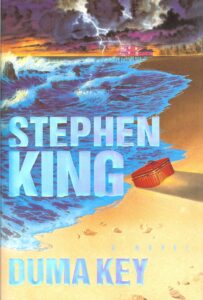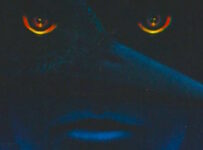Welcome back to Inconstant Reader, the feature column that explores Stephen King’s books in the order they were published — sort of! Warning: this key unlocks some spoilers.
“I was supposed to lose my life, but I didn’t.“
It’s hard to read lines like that from DUMA KEY without imagining Stephen King’s life going in a very different direction. Published almost a decade after the car accident that very nearly resulted in the writer’s leg being amputated, his lead character Edgar Freemantle could almost be an avatar for an alternate King scattered somewhere in his vast Dark Tower multiverse.
We first encountered Edgar in the short story ‘Memory,’ a 2006 tale originally published in Tin House and included as an annex to Blaze. That story casts Edgar as a contractor injured on a construction site. After losing parts of several limbs, and his vision, he is prone to mood swings and amnesia. King has publicly stated that this was inspired by how much and little he could remember of his own 1999 accident.
It’s also where King chooses to open DUMA KEY, recrafting this short into the first chapter of this lengthy novel. In fact, reading this a few weeks after ‘Memory’ it struck me as an interesting thought exercise of reliving the same traumatic experience through two different lenses. Just as with the short story, Edgar’s unpredictable anger causes his wife to leave him. The short ends with Edgar euthanising an injured dog, finding that channelling his memories has given him the strength he needs.
In DUMA KEY this is just the starting point. We follow Edgar south to the titular island in the Florida Keys. Rekindling his love of sketching at the advice of his therapist, he meets the two other residents of Duma Key. There’s octogenarian heiress Elizabeth Eastlake, who suffers from late-stage Alzheimer’s, and Wireman, a former attorney who now acts as her live-in carer. He has his own skeletons, as the survivor of a suicide attempt following the sudden accidental death of his wife and child.
From here, King spends his time exploring multiple perspectives on loss, grief, and recovery through the lens of a ghost story. As the site’s paranormal activity impacts Edgar’s art, he begins to reveal psychic visions. His ex-wife’s affair, for example, or the suicidal ideation of a mutual friend. Edgar’s work attracts the attention of the art world, but his painting seems to have the ability to impact his surroundings, right down to curing Wireman of serious medical ailments. It’s Stephen King, so there’s also something sinister about them as well.
Much of this is familiar territory for King’s Constant Readers. Yes, there’s the expected Dark Tower references to roses and the number 19, and the psychic artist recalls both Patrick Danville in Insomnia and Seth Garin from The Regulators. Edgar refers to himself as a gunslinger at one point. On a more basic level, the psychic energy of a ‘haunted’ and isolated property might have you thinking about The Shining on more than one occasion. (I’m not alone: Mark Rahmer of The Seattle Times goes into more detail about the similarities).
Yet there’s a complexity to this storytelling as well multiple narrative timelines as it builds towards the Big Finish. Without revealing too much, there’s some genuine surprises and heartbreaks in the last act, and it honestly surprised me how much this affected me. King effortlessly (at least as far as the read is concerned) crafts these deep and meaningful friendships in his books, and Edgar and Wireman is one of the more impactful.
If we’re going to get super deep on this one, and to bring this full circle, it’s arguable that this narrative reveals something of a darker side of the writer’s vision. A Dark Half if you will. One of Edgar’s final acts is a painting so destructive that it will destroy his surroundings. One wonders what destruction that alternative Stephen King may have wrought in a darker moment.
So, even though there are moments in DUMA KEY that feel all too familiar, here I am weeks later still reflecting on it. It’s King playing with some big concepts, some more terrifying than others. Perhaps even the writer didn’t dare plumb all of its depths.
Next on Inconstant Reader: Just After Sunset, King’s collection of 13 short stories that was accompanied by a series of animated videos.






